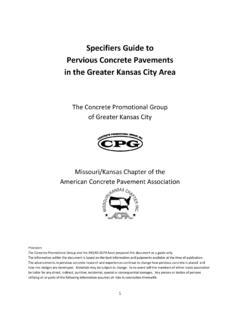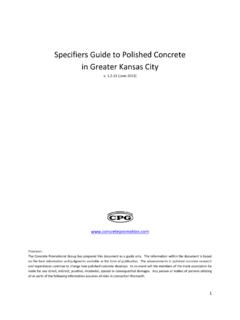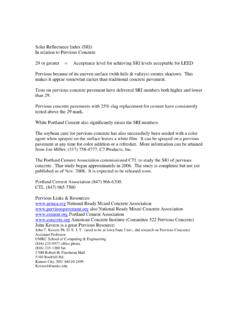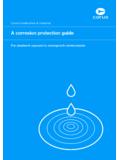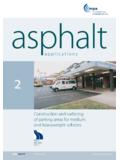Transcription of Specifiers Guide to Pervious Concrete in Kansas …
1 Specifiers Guide to Pervious Concrete Pavements in the Greater Kansas City Area The Concrete Promotional Group of Greater Kansas City Missouri/ Kansas Chapter of the American Concrete pavement Association Provision: The Concrete Promotional Group and the MO/KS ACPA have prepared this document as a Guide only. The information within the document is based on the best information and judgments available at the time of publication. The advancements in Pervious Concrete research and experiences continue to change how Pervious Concrete is placed and how mix designs are developed. Materials may be subject to change.
2 In no event will the members of either trade association be liable for any direct, indirect, punitive, incidental, special or consequential damages. Any person or bodies of persons utilizing all or parts of the following information assumes all risks in connection therewith. 1 Forward This Guide has been assembled for Specifiers who consider Pervious Concrete for stormwater mitigation. It takes into consideration the local climate (freeze/thaw) and clay soils typical of the Kansas City Metro region, as well as local resources/materials. The information found within this document is meant to facilitate the design and installation of Pervious Concrete pavement systems for stormwater mitigation.
3 The EPA Phase II, NPDES stormwater mandates require post development runoff to be equal to or less than pre development runoff. Pervious Concrete pavement filters, cools and detains (temporary storage) stormwater, while also serving as a parking lot, sidewalk, or pavement . Pervious Concrete becomes a multipurpose product, fulfilling stormwater requirements while reducing site footprint and providing a productive pavement surface. Pervious Concrete pavement is a recognized green building construction material. For those seeking USGBC LEED certification or other green building systems, Pervious Concrete can aid in achieving points in these categories: Reduced Site Disturbance: Development Footprint, Stormwater Management: Rate & Quantity, Landscape & Exterior Design to Reduce Heat Islands, Improved Energy Efficiency to Adjacent Buildings, Regional Materials, possibly Recycled Content and other Innovative Credits.
4 The Pervious Concrete pavement systems consist of a surface layer of specially designed Concrete consisting of 20% to 25% voids to allow rainwater to rapidly flow through the pavement . This layer sits on a subbase of clean coarse aggregate ~40% voids) to act as temporary storage for rainwater. (Other parts of the world with sandy soils may not need this storage layer, but because of the clay soils in the Kansas City area it is mandatory in this market.) The last part of the system consists of a filter fabric placed under the aggregate storage layer and on top of the soil subgrade. This filter fabric shall also wrap up the sides of the subbase and Pervious Concrete .
5 This protects the subbase and Pervious layers from infiltration of surrounding soils or fines which can migrate into and clog up the system. Refer to the diagram below for a visual understanding of the description. The Concrete Promotional Group of Greater Kansas City (CPG) in conjunction with the MO/KS Chapter of the American Concrete pavement Association (MO/KS ACPA) provides Pervious Concrete pavement Certification in Kansas City. It is mandatory for the Concrete Contractor placing the Pervious Concrete as well as the Ready Mixed Concrete Supplier to be Pervious Concrete Certified. The National Ready Mixed Concrete Association (NRMCA) also offers a Pervious Concrete Contractor Certification.
6 The programs are similar and both are equally acceptable. The CPG & MO/KS ACPA version not only has a written exam (must pass 80% or better), but also has a field placement exam. The certification is open and recommended to all parties involved in the Pervious construction process including: engineers, architects, landscape architects, stormwater engineers, general contractors, inspectors, field testing personnel, etc. Actual project conditions may require modifications or additions to this Guide . Specific site conditions, constructability issues, weather conditions, code regulations all vary by project.
7 Refer to Pervious Handbook on the CPG website as a companion piece for additional information. 2 Notable Updates to the Specifiers Guide as of 2017 Pervious Concrete has now been used in significant quantities in the United States since the early 2000s. Originally the design and construction guidance was developed out of experiences in climates and markets in warmer and more humid locations than Kansas City. Consequently, certain practices common in those locations do not produce consistently durable Pervious Concrete and have been removed from this Guide . The most notable and significant changes are: Water reducing admixtures used in Pervious Concrete mixture should be a polycarboxylate.
8 Polycarboxylate admixtures are more effective and durable than older water reducer types. For broad application polycarboxylate water reducing agents, the dosage rate should be adjusted to achieve high range reduction. Hydration stabilizing admixtures (not retarders) are required to maintain sufficient workability. A dosage rate chart has been included to allow adjusting dosage for air temperature, humidity, and Concrete haul time. Large aggregates produce an overly rough texture which is not appealing for an owner's perspective. The maximum recommended aggregate size is now 3/8 inch. Joints are installed in Concrete to control random cracking.
9 However, joint durability in Pervious Concrete is especially problematic. Generally sawn joints have performed better than formed joints, but pose issues of plastic handling and slurry cleaning. Since Pervious Concrete already possess a much different texture than conventional Concrete , random cracks are much less of a visual issue. In attempt to reduce problems related to joints in Pervious Concrete , joints are no longer required. A sufficient dosage of fibers is required to help control random cracking. Ground granulated blast furnace slag, also known as slag cement or just slag, is not recommended in Pervious Concrete in other areas of the The concern is that Concrete containing slag appears to be more susceptible to deicer damage and to react adversely with the hydration stabilizer.
10 We are hesitant to use slag and advise to proceed with caution. We are open to ongoing research and keeping an eye on slag use in Pervious . Ordering and delivery of Pervious Concrete should have a 4 yard minimum and an 6 yard maximum for dry batch plants, and an 8 yard maximum for wet batch plants. 6 yard batches are the norm. 3 Pervious Concrete Guidelines for the Greater Kansas City Area SECTION 1 GENERAL Scope This Guide addresses the equipment, materials, and processes necessary for Pervious Concrete pavement construction in the Greater Kansas City Area. It includes preparation of subgrade for temporary detention of stormwater.
